Finally! Keto Lemon Cookies That Don’t Taste… Well, Keto.
Let’s be honest for a second. So many keto desserts are a letdown. I’ve spent more than my fair share of time in professional kitchens, and I can tell you that low-carb baking is a whole different ballgame. It’s pure science. You can’t just wing it and expect good results, which is why so many people end up with cookies that are gritty, fall apart if you look at them funny, or have that weird, artificial aftertaste.
In this article
I’ve been there. My first few attempts at keto treats were, frankly, sawdust pucks. But the goal was never just to make a cookie that fits a diet. The goal was to make a genuinely delicious cookie that just so happens to be low-carb. These lemon cookies are the result of that mission. We’re talking a soft, slightly chewy center, a delicate crumb, and a bright, zesty flavor that tastes like sunshine. This isn’t just a recipe; it’s the playbook for getting it right every time.

First Things First: Understanding Your Keto Baking Toolbox
In traditional baking, you have a predictable team: flour, sugar, and butter. They work together perfectly. In keto baking, we’re subbing in a whole new lineup of ingredients, and you’ve got to understand how they play together to win the game.
The Flour Situation: A Tale of Two Flours
You can’t just swap regular flour for one low-carb alternative. It just doesn’t work. The secret is a blend of almond and coconut flour to get that perfect cookie texture.
- Super-Fine Blanched Almond Flour: This is your star player. It’s made from almonds with the skins removed and ground into a powder, giving you a tender, rich base with a clean flavor. Heads up: you absolutely need “super-fine” for this. Using a coarse almond meal will make your cookies heavy and gritty. Almond flour provides the fat and body. You can find great options from brands like Bob’s Red Mill or Anthony’s on Amazon or at health food stores. A big bag might run you $10-$15, but it’ll last for several batches. For a budget-friendly option, Costco’s Kirkland Signature brand is fantastic.
- Coconut Flour: This one is a supporting character, but a powerful one. It’s basically a sponge, soaking up a ton of liquid. A little bit goes a long way to creating a softer, more cake-like texture and binding the dough. We use just enough to get that effect. Too much (and I learned this the hard way) and you’re back in sawdust territory.
By the way, for those with nut allergies, subbing almond flour is tricky. Its properties are pretty unique. Some bakers have success with sunflower seed flour, but be warned: it can sometimes react with baking powder and give your cookies a slightly greenish tint! It’s an interesting experiment if you’re feeling adventurous.

The Sweetener Showdown
Erythritol is the go-to sweetener for keto because it doesn’t impact blood sugar. But it comes with a couple of quirks you need to manage.
The first is crystallization. As it cools, erythritol can sometimes form little crunchy crystals. The non-negotiable solution is to use a powdered or confectioners’ version. If you only have the granular kind, just blitz it in a clean coffee grinder or a high-powered blender until it’s a fine powder. Problem solved.
The second thing is what some people call the “cooling effect”—that slight minty-cool sensation it can leave in your mouth. Honestly, some people don’t even notice it, but if you’re sensitive to it, here’s the deal:
- Erythritol: This is our base for this recipe. It’s affordable and widely available. Using the powdered form is key to a smooth texture.
- Allulose: This is a fantastic alternative that doesn’t crystallize or have a cooling effect. The downside? It’s pricier and can make baked goods brown a bit faster, so you might need to knock 10-15 degrees off your oven temp.
- Monk Fruit Blends: These usually mix monk fruit extract with erythritol. The monk fruit helps mask the cooling effect and adds a more rounded sweetness. They’re a great choice but can also be a little more expensive.

Fats, Binders, and The Magic of Lift
A few other key players round out our ingredient list. Unsalted butter gives these cookies an unbeatable flavor and richness. Make sure it’s softened to room temperature—around 65°F. If it’s too cold, it won’t mix properly; if it’s melted, your cookies will spread into greasy, sad puddles. A large, room-temperature egg is our main binder, and it’s important it’s not cold. Dropping a cold egg into your creamed butter will make the fat seize up into clumps.
And finally, baking powder. Since we have no gluten, this is what gives our cookies a bit of lift and keeps them from being dense little bricks. Quick tip: test if your baking powder is still active by dropping a teaspoon into hot water. If it fizzes up like a science experiment, you’re good to go.
Okay, Let’s Bake Some Amazing Cookies
A great recipe is only half of it. The right technique is what takes these from “good for keto” to just plain “good.”

The Official Keto Lemon Cookie Recipe
I highly, highly recommend using a digital kitchen scale for baking. It costs about $15 on Amazon and is the single best tool for getting consistent, professional results. It’s how all the pros do it for a reason!
Yields: 18-20 cookies
Macros per cookie (approximate): 1.5g Net Carbs, 10g Fat, 2g Protein
Prep time: 20 minutes
Chill time: At least 1 hour (don’t skip this!)
Bake time: 12-15 minutes
What You’ll Need:
- Digital kitchen scale
- Stand mixer or a hand mixer (or a bowl, a whisk, and some elbow grease!)
- Baking sheets and parchment paper
- A Microplane or other fine zester
- A small cookie scoop (about 1.5 tablespoons)
Ingredients:
- 113g (1/2 cup) Unsalted Butter, softened
- 100g (1/2 cup + 1 tbsp) Powdered Erythritol
- 1 large Egg, room temperature
- 1 tbsp Fresh Lemon Zest (from ~1 large lemon)
- 30ml (2 tbsp) Fresh Lemon Juice
- 1 tsp Vanilla Extract
- 180g (1 3/4 cups) Super-Fine Blanched Almond Flour
- 40g (1/4 cup + 1 tbsp) Coconut Flour
- 1 tsp Baking Powder
- 1/4 tsp Salt

Step-by-Step Guide (With All The Secrets)
1. Get Ready: Line two baking sheets with parchment paper. This gives you a non-stick surface and helps prevent the bottoms from getting too dark.
2. Mix the Dry Stuff: In a medium bowl, whisk together the almond flour, coconut flour, baking powder, and salt. Don’t just dump them in—whisking evenly distributes everything, so you don’t get a bitter bite of baking powder.
Pro Tip (Time-Saver!): Go ahead and make a big batch of this dry mix! Quadruple the recipe and store it in an airtight container. When you’re ready for cookies, just measure out what you need. Half the work is already done.
3. Cream the Butter & Sweetener: Using a mixer, beat the softened butter and powdered erythritol for 2-3 minutes. You’re just looking for a smooth paste. (If you’re doing this by hand, use a whisk and get ready for a little arm workout! Just keep going until it’s smooth and combined.)

4. Add the Wet Ingredients: Add the room-temp egg, lemon zest, lemon juice, and vanilla. Mix on low until just combined. Oh yeah, and always zest your lemon before you juice it. It’s a thousand times easier.
5. Combine It All: On the mixer’s lowest speed, slowly add the dry mix. Stop as soon as the dough comes together. If you over-mix, the almond flour can get oily. The dough will feel soft, maybe a little sticky. That’s perfect.
6. The Crucial Chilling Step: This is the most important part. Cover the dough and chill it in the fridge for at least one hour. I once skipped this step because I was in a hurry, and my cookies spread into thin, greasy, depressing wafers. Chilling solidifies the butter so they hold their shape, lets the coconut flour fully hydrate (bye-bye, grit!), and allows the flavors to deepen. Seriously, don’t skip it.
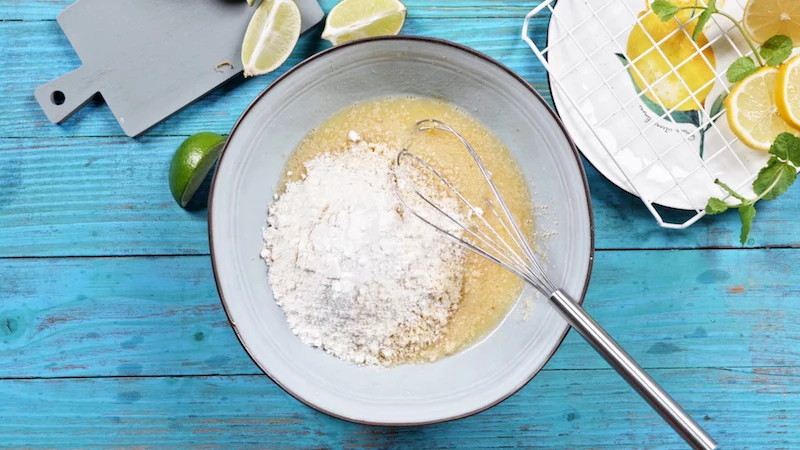
7. Portion and Bake: Preheat your oven to 350°F (175°C). Use a cookie scoop for evenly sized cookies that will bake at the same rate. Roll them into balls and place them about 2 inches apart on your baking sheets.
8. The Bake: Bake for 12-15 minutes. The edges should look set and lightly golden, but the centers will still be soft. Pull them out! They’ll firm up as they cool. Over-baking is the number one cause of dry keto cookies. I always set a timer for 11 minutes just to check, since every oven has its own personality.
9. Cool Down: Let the cookies cool on the baking sheet for 5-10 minutes. They’re delicate when hot. Then, move them to a wire rack to cool completely. This lets air circulate so they don’t get soggy on the bottom.
Troubleshooting Like a Pro
Even the best of us have a batch go wrong. Here’s a quick field guide:
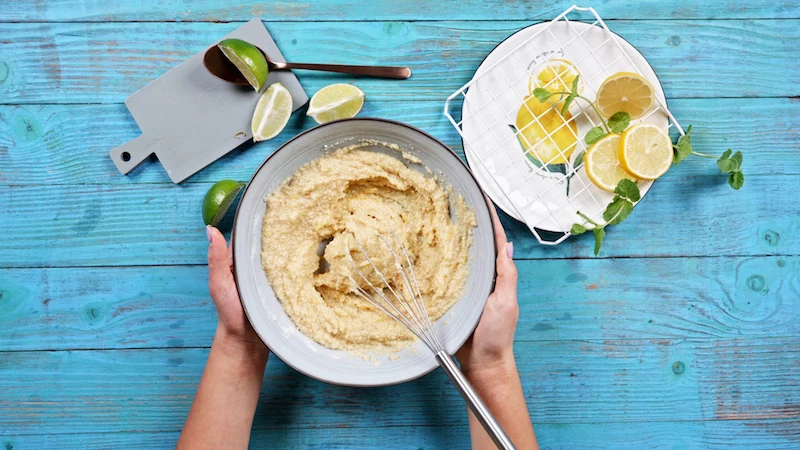
- Help! My cookies are flat! Your butter was probably too soft, or you didn’t chill the dough long enough. Make sure your dough is firm and cold before it hits the oven.
- Why are my cookies so dry and crumbly? You likely either used a bit too much coconut flour (a scale prevents this!) or you over-baked them. Remember, pull them when the centers still look soft.
- Ugh, they’re gritty. What happened? Two likely culprits: you used granular sweetener instead of powdered, or you didn’t let the dough chill long enough for the coconut flour to hydrate.
Want to Get Fancy? A Perfect Keto Lemon Glaze
A simple glaze makes these cookies look and taste extra special. The trick is to sift your sweetener.
Simply whisk together about 2/3 cup (80g) of sifted powdered erythritol with 1-2 tablespoons of fresh lemon juice and a tablespoon of heavy cream (or coconut cream). The cream makes the glaze opaque and creamy. You want it thick but pourable. Drizzle it over the cookies after they are completely cool, or the glaze will just melt.
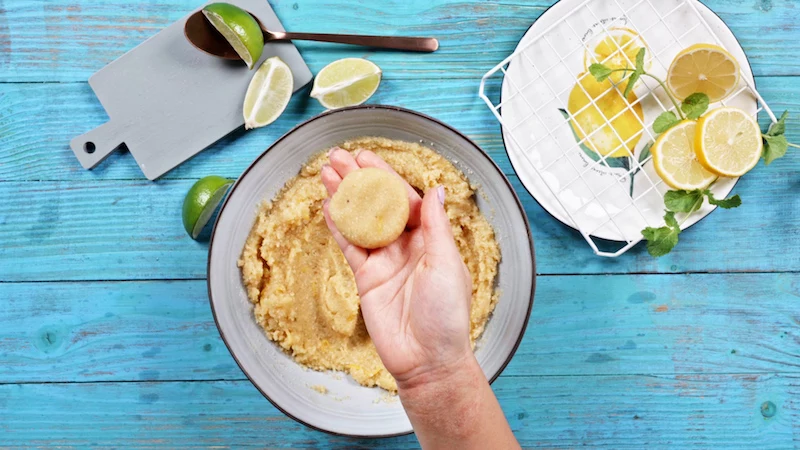
Storage and a Final Word
Store these in an airtight container at room temperature for up to 5 days. For longer storage, they freeze beautifully for up to 3 months. Just thaw them on the counter when you’re ready for a treat.
And a quick heads-up: I’m a baker, not a doctor. This info is for delicious, culinary purposes. If you’re on a keto diet for medical reasons, always chat with your doc first.
Baking is a craft you build with practice. Now you have the foundation to make some truly incredible cookies. So, what’s your biggest keto baking headache? Drop a comment below and let’s troubleshoot together!
Inspirational Gallery
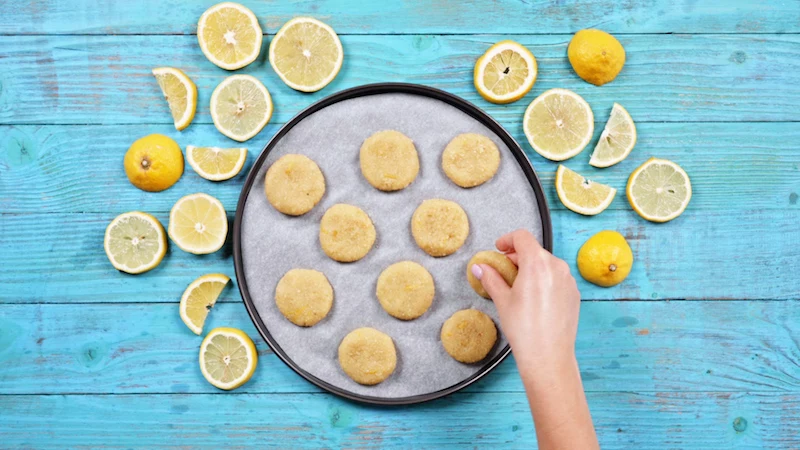
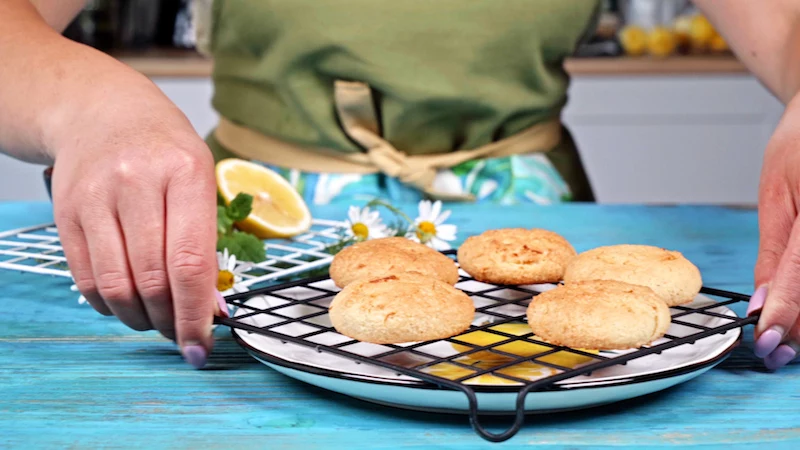
Erythritol: This is the most common keto sweetener, often found in blends like Swerve. It provides excellent bulk and sweetness with zero calories, but some people notice a slight cooling sensation on the tongue. It can also recrystallize in glazes or when cooled, giving a slightly crunchy texture.
Allulose: A rising star in keto baking, allulose behaves much more like real sugar. It browns beautifully, doesn’t recrystallize, and has no aftertaste. It’s slightly less sweet than sugar, so you might need a little more. Brands like Wholesome are a great source.
For these cookies, either works, but allulose will yield a softer texture and a more authentic sugar-glaze finish.

Did you know the most intense lemon flavor isn’t in the juice, but in the oils trapped in the zest?
To capture that pure, bright essence, use a fine grater like a Microplane. It shaves off only the yellow part of the peel, avoiding the bitter white pith underneath. Rubbing the zest into your keto sweetener before mixing releases those fragrant oils, infusing every single bite with an authentic, sun-drenched lemon flavor that extracts can’t replicate.

- A perfectly chewy center with crisp edges.
- A bright, zesty flavor that’s never artificial.
- A beautiful golden hue without any browning agents.
The secret? Chilling the dough. Letting the cookie dough rest in the refrigerator for at least 30 minutes is non-negotiable. This allows the coconut flour to fully hydrate and the fats in the almond flour to solidify, preventing the cookies from spreading into thin, sad pancakes in the oven.

How do you get that perfect, crackly white glaze without using powdered sugar?
It’s all about the right low-carb alternative. Use a powdered keto sweetener like Swerve Confectioners or finely blitzing granular erythritol in a high-powered blender. In a small bowl, start with about a cup of the powdered sweetener and add fresh lemon juice one teaspoon at a time. Whisk vigorously until you have a thick but pourable consistency. For a creamier finish, add a tiny splash of heavy cream or unsweetened almond milk. Always wait for the cookies to cool completely before glazing!

- Don’t overmix the dough. Once the ingredients are just combined, stop. Overworking almond flour can cause it to release its oils, resulting in a greasy cookie.
- Uniformity is key. Use a small cookie scoop (about 1.5 tablespoons) to ensure all your cookies are the same size. This is crucial for even baking.
- Watch the edges, not the center. Keto cookies often look underdone in the middle when they’re ready. Pull them from the oven when the edges are just beginning to turn a light golden brown. They’ll set up as they cool on the baking sheet.

A baker’s truth: Moisture is the enemy of a fresh keto cookie. Because almond flour lacks the gluten structure of traditional flour, these cookies are more susceptible to becoming soft or cakey after a day. To preserve that perfect just-baked texture, store them in a single layer in an airtight container at room temperature. Placing a folded paper towel inside the container can help absorb any excess moisture and extend their freshness for an extra day or two.
Once you’ve mastered the classic lemon, the cookie becomes a canvas. Think about adding a tablespoon of poppy seeds for a classic pairing with a delightful crunch. For a more sophisticated, floral note, try mixing in a teaspoon of finely chopped, culinary-grade dried lavender. Or, for a taste of summer, a bit of finely chopped fresh rosemary adds a surprising and delicious herbaceous twist.










